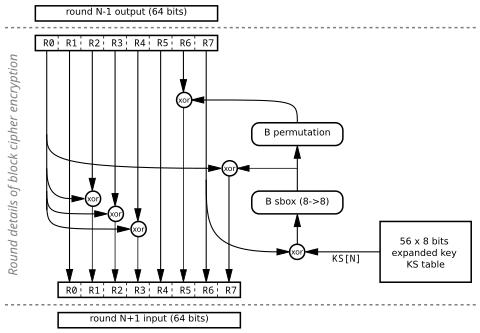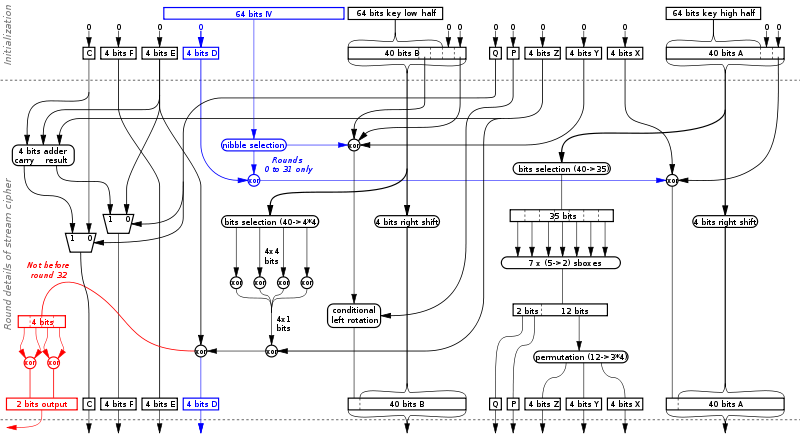
The Advanced Encryption Standard (AES), also known by its original name Rijndael, is a specification for the encryption of electronic data established by the U.S. National Institute of Standards and Technology (NIST) in 2001.
Blowfish is a symmetric-key block cipher, designed in 1993 by Bruce Schneier and included in many cipher suites and encryption products. Blowfish provides a good encryption rate in software, and no effective cryptanalysis of it has been found to date. However, the Advanced Encryption Standard (AES) now receives more attention, and Schneier recommends Twofish for modern applications.

In cryptography, a cipher is an algorithm for performing encryption or decryption—a series of well-defined steps that can be followed as a procedure. An alternative, less common term is encipherment. To encipher or encode is to convert information into cipher or code. In common parlance, "cipher" is synonymous with "code", as they are both a set of steps that encrypt a message; however, the concepts are distinct in cryptography, especially classical cryptography.

The Data Encryption Standard is a symmetric-key algorithm for the encryption of digital data. Although its short key length of 56 bits makes it too insecure for modern applications, it has been highly influential in the advancement of cryptography.

In cryptography, the one-time pad (OTP) is an encryption technique that cannot be cracked, but requires the use of a single-use pre-shared key that is larger than or equal to the size of the message being sent. In this technique, a plaintext is paired with a random secret key. Then, each bit or character of the plaintext is encrypted by combining it with the corresponding bit or character from the pad using modular addition.
In cryptography, RC4 is a stream cipher. While it is remarkable for its simplicity and speed in software, multiple vulnerabilities have been discovered in RC4, rendering it insecure. It is especially vulnerable when the beginning of the output keystream is not discarded, or when nonrandom or related keys are used. Particularly problematic uses of RC4 have led to very insecure protocols such as WEP.

In cryptography, a block cipher mode of operation is an algorithm that uses a block cipher to provide information security such as confidentiality or authenticity. A block cipher by itself is only suitable for the secure cryptographic transformation of one fixed-length group of bits called a block. A mode of operation describes how to repeatedly apply a cipher's single-block operation to securely transform amounts of data larger than a block.

In cryptography, ciphertext or cyphertext is the result of encryption performed on plaintext using an algorithm, called a cipher. Ciphertext is also known as encrypted or encoded information because it contains a form of the original plaintext that is unreadable by a human or computer without the proper cipher to decrypt it. This process prevents the loss of sensitive information via hacking. Decryption, the inverse of encryption, is the process of turning ciphertext into readable plaintext. Ciphertext is not to be confused with codetext because the latter is a result of a code, not a cipher.
A5/1 is a stream cipher used to provide over-the-air communication privacy in the GSM cellular telephone standard. It is one of several implementations of the A5 security protocol. It was initially kept secret, but became public knowledge through leaks and reverse engineering. A number of serious weaknesses in the cipher have been identified.
Wired Equivalent Privacy (WEP) is a severely flawed security algorithm for 802.11 wireless networks. Introduced as part of the original IEEE 802.11 standard ratified in 1997, its intention was to provide data confidentiality comparable to that of a traditional wired network. WEP, recognizable by its key of 10 or 26 hexadecimal digits, was at one time widely used, and was often the first security choice presented to users by router configuration tools.
In cryptography, an adversary's advantage is a measure of how successfully it can attack a cryptographic algorithm, by distinguishing it from an idealized version of that type of algorithm. Note that in this context, the "adversary" is itself an algorithm and not a person. A cryptographic algorithm is considered secure if no adversary has a non-negligible advantage, subject to specified bounds on the adversary's computational resources. "Negligible" usually means "within O(2−p)" where p is a security parameter associated with the algorithm. For example, p might be the number of bits in a block cipher's key.
In cryptography, Galois/Counter Mode (GCM) is a mode of operation for symmetric-key cryptographic block ciphers which is widely adopted for its performance. GCM throughput rates for state-of-the-art, high-speed communication channels can be achieved with inexpensive hardware resources.
Card sharing, also known as control word sharing, is a method of allowing multiple clients or digital television receivers to access a subscription television network with only one valid subscription card. This is achieved by electronically sharing a part of the legitimate conditional access smart card's output data, enabling all recipients to gain simultaneous access to scrambled DVB streams, held on the encrypted television network.

In cryptography, Corrected Block TEA is a block cipher designed to correct weaknesses in the original Block TEA.
In cryptography, a distinguishing attack is any form of cryptanalysis on data encrypted by a cipher that allows an attacker to distinguish the encrypted data from random data. Modern symmetric-key ciphers are specifically designed to be immune to such an attack. In other words, modern encryption schemes are pseudorandom permutations and are designed to have ciphertext indistinguishability. If an algorithm is found that can distinguish the output from random faster than a brute force search, then that is considered a break of the cipher.
The Content Scramble System (CSS) is a digital rights management (DRM) and encryption system employed on many commercially produced DVD-Video discs. CSS utilizes a proprietary 40-bit stream cipher algorithm. The system was introduced around 1996 and was first compromised in 1999.
bcrypt is a password-hashing function designed by Niels Provos and David Mazières, based on the Blowfish cipher and presented at USENIX in 1999. Besides incorporating a salt to protect against rainbow table attacks, bcrypt is an adaptive function: over time, the iteration count can be increased to make it slower, so it remains resistant to brute-force search attacks even with increasing computation power.
In cryptography, format-preserving encryption (FPE), refers to encrypting in such a way that the output is in the same format as the input. The meaning of "format" varies. Typically only finite sets of characters are used; numeric, alphabetic or alphanumeric. For example:
crypt is a POSIX C library function. It is typically used to compute the hash of user account passwords. The function outputs a text string which also encodes the salt, and identifies the hash algorithm used. This output string forms a password record, which is usually stored in a text file.

Speck is a family of lightweight block ciphers publicly released by the National Security Agency (NSA) in June 2013. Speck has been optimized for performance in software implementations, while its sister algorithm, Simon, has been optimized for hardware implementations. Speck is an add–rotate–xor (ARX) cipher.









